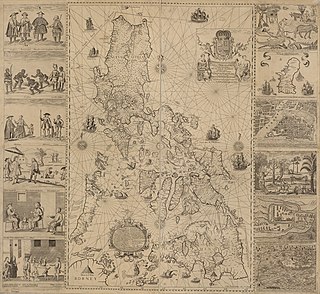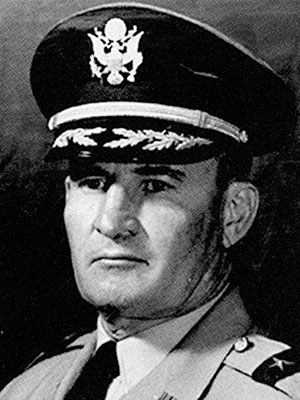
The Philippine Scouts (Filipino: Maghahanap ng Pilipinas/Hukbong Maghahanap ng Pilipinas) was a military organization of the United States Army from 1901 until after the end of World War II. These troops were generally Filipinos and Filipino-Americans assigned to the United States Army Philippine Department, under the command of American commissioned officers (though a handful of Filipino Americans received commissions from the United States Military Academy). Philippine Scout units were given the suffix "(PS)", to distinguish them from other U.S. Army units.

Malaybalay, officially the City of Malaybalay, is a component city and capital of the province of Bukidnon, Philippines. According to the 2020 census, it has a population of 190,712 people.

The Philippines campaign, also known as the Battle of the Philippines or the Fall of the Philippines, was the invasion of the United States territory of the Philippines by the Empire of Japan during the Pacific Theater of World War II. The operation to capture the islands, which was defended by the U.S. and Philippine Armies, was intended to prevent interference with Japan's expansion in Southeast Asia.

Camp O'Donnell is a current military base and former United States military reservation in the Philippines located on Luzon island in the municipality of Capas in Tarlac. It housed the Philippine Army's newly created 71st Division and after the Americans' return, a United States Army camp. During World War II, the reservation was used as a prisoner-of-war camp for Filipino and American soldiers captured by Japan during its successful invasion of the Philippines. About 60,000 Filipino and 9,000 Americans were housed at the camp. During the few months in 1942 that Camp O'Donnell was used as a prisoner-of-war camp, about 20,000 Filipinos and 1,500 Americans died there of disease, starvation, neglect, and brutality.

The Japanese occupation of the Philippines occurred between 1942 and 1945, when the Japanese Empire occupied the Commonwealth of the Philippines during World War II.
Charles Arthur Stafford was a Captain and physician in the Medical Corps of the United States Army during World War II. Stafford was posthumously awarded the Silver Star for his actions in the Battle of Java.

The 28th Bomb Squadron is a squadron of the United States Air Force. It is assigned to the 7th Operations Group, Global Strike Command, stationed at Dyess Air Force Base, Texas. The squadron is equipped with the Rockwell B-1B Lancer.

During the Japanese occupation of the islands in World War II, there was an extensive Philippine resistance movement, which opposed the Japanese and their collaborators with active underground and guerrilla activity that increased over the years. Fighting the guerrillas – apart from the Japanese regular forces – were a Japanese-formed Bureau of Constabulary, the Kenpeitai, and the Makapili. Postwar studies estimate that around 260,000 people were organized under guerrilla groups and that members of anti-Japanese underground organizations were more numerous. Such was their effectiveness that by the end of World War II, Japan controlled only twelve of the forty-eight provinces.

The 81st Infantry Division was a reserve division of the Philippine Army under the United States Army Forces in the Far East (USAFFE). It was established in the prewar period and fought 1941–1942. Its troops are from Cebu, Bohol, and Leyte but most of its troops are Americans and junior officers are Filipinos coming mostly from Luzon. The division served in defense of Mindanao but it never commanded the 4 of its maneuver regiments but was supplemented with 61st Infantry from Panay and 73rd Infantry from Negros. Also, 2nd Regular Regiment was transferred to its command in the early part of Japanese invasion of Mindanao.

The 101st Infantry Division was one the reserve divisions of the Philippine Army under the United States Army Forces in the Far East (USAFFE)'s 10th Military district mainly entire island of Mindanao.
The 102nd Infantry Division was a division of the Philippine Army under the United States Army Forces in the Far East (USAFFE).

Edward Ernest McClish (1909-1993) was an American military officer in the Philippines in World War II. During the Japanese occupation of the Philippines, Lt. Colonel McClish commanded a division of Filipino guerrillas on Mindanao island.
Visayas-Mindanao Force was a military formation created in November 1941 to command all soldiers of the US Army, US Philippine Scouts, Philippine Army, and Philippine Constabulary in the southern islands of the Philippines. Colonel William F. Sharp was appointed as commanding general and was promoted to Brigadier General in November 1941 and later Major General. His executive officer was Major Howard Edmands. He was just starting to organize his command and train his soldiers into a fighting unit when the war started on December 7, 1941.

102nd Infantry Regiment is a military unit of the Philippine Commonwealth Army during World War II. I was activated in September 1941 and inducted to USAFFE on the same month. It fought under 101st Infantry Division

103rd Infantry Regiment is a unit activated by the Philippine Army during World War II. I was organized in Mindanao in November 1941 which was not yet ready to fight when the war broke out.
101st Field Artillery Regiment is a reserve field artillery regiment activated in August 1941 as part of 101st Infantry Division based in Camp Casisang in Bukidnon Province. Visayas-Mindanao Force only received 8 QF 2.95inch Mountain Guns and divided it between two divisions in the island 101st and 81st in Lanao sector. The regiment retrained into fighting as infantry due to lack of guns to operate.

The 61st Field Artillery Regiment was a reserve unit of the Philippine Army, activated in August 1941 as part of the 61st Infantry Division, which was based in Panay. The regiment was initially organized to serve as an artillery unit; however, it saw combat as infantry during World War II.
John P. Woodridge is an American Army officer who served in World War II in the Philippines. He was known as commander 81st Field Artillery Regiment that fought Japanese in Mindanao in May 1942. He was POW and he boarded a hell ship to be taken to Mukden, Manchuria but was bombed and he went missing. He was promoted to full Colonel posthumously in 1945.

John Hugh McGee, is a US Army officer who is known for his combat exploits in Mindanao and escape during World War II. His contribution in Korean War was also credited by his peers and superiors. He served with US Army for 30 years from 1931 to 1961.
Russell J. Nelson, is a US Army colonel who served both on World War I and World War II. He was known to comma.nd Cotabato subsector and Japanese invasion of Mindanao on later Japanese invasion of the Philippines in 1942. He surrendered his regiment upon the surrendered of all forces in the Philippines in May 1942. He went missing at sea when his transport ship was bombed and sunk.















